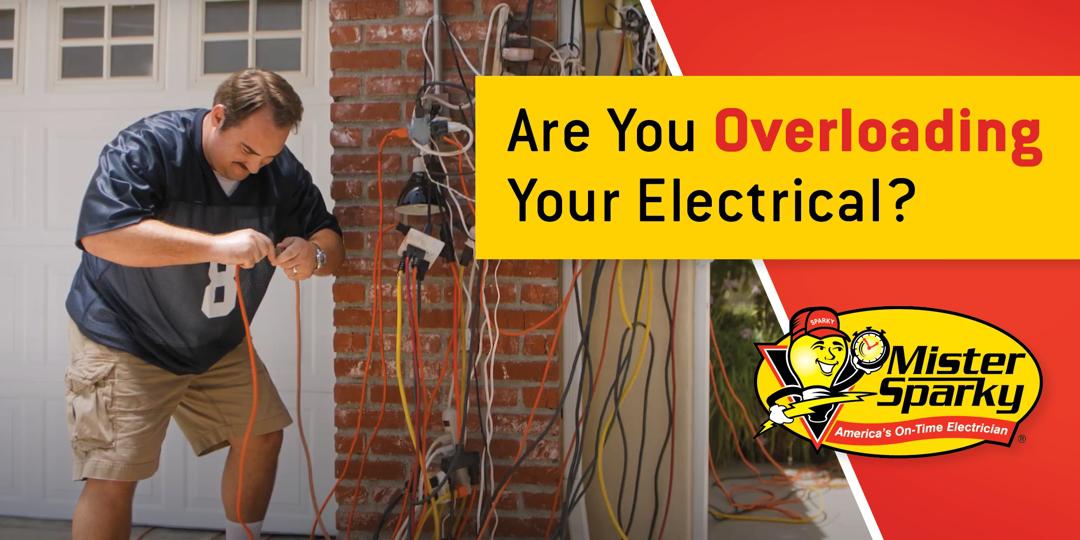Overloading your electrical system can happen bit by bit (or more accurately, plug by plug) over time, or all at once when you plug in too much at once.
That’s the idea behind this silly-but-serious video showing “Bob Malarky” plugging in way too much so he can watch the big game.
What Can Mister Sparky Do?
In the video, you hear the Mister Sparky service tech tell Bob Malarky’s neighbor about all the upgrades she made:
- Four new outlets, all with USB
- Projector hooked up with a dedicated line
Meanwhile, poor Bob has a dangerous amount of cords, extension cords, and various items plugged in over at his house. Read this Realtor.com article about what you should not plug in to an extension cord.
Also, consider these possibilities when making electrical updates at your own home:
- Adding outdoor outlets or outlets to a patio area
- Installing a projector and screen outside
- Upgrading your lighting in your TV room for optimum viewing
Making electrical changes can be both practical and improve your living space and experience with the right capacity and looks.
Stay Safe with Mister Sparky
A common issue that can impact electrical devices and systems in homes is a power surge.
A power surge can enter the home, fry the circuit breaker and spread to various outlets in the house. If an appliance is plugged directly into the electrical system, it may not survive the sudden burst of electricity. Surges can also originate inside your house and potentially burn out anything that's plugged in, from your computer to your television to even your refrigerator. In order to protect your valuable electronics and appliances, make sure you understand what a surge is and how you can limit the damage.
What is a power surge?
A power surge occurs when there is a sudden, significant increase in the voltage of electricity flowing through your circuits. In the United States, most electronics and appliances work on 120 volts. During a surge, there's a brief but dramatic boost in that voltage rate, which brings too much electricity running through your wires.
What causes a power surge?
Surges happen for lots of reasons: weather conditions, transformer problems, the sudden return of power after an outage. Lightning is a prime culprit, so be especially wary during a thunderstorm. But surges can be unpredictable -- you never know when an unexpected disruption will hit the power grid. Lights flickering on and off is a sign of a power surge. Also look for electronics that have been reset, such as a microwave clock flashing “12:00.” If you live in an area with frequent blackouts, you may be especially vulnerable.
If you have a lot of appliances running at once, you can actually increase your chance of having a surge. When high-powered electrical devices such as AC units and refrigerators are working at peak capacity, it takes a lot of energy to keep their motors and compressors going. This high demand can upset the steady voltage flow through your electrical system.
What appliances are at risk?
Anything motor-driven is particularly vulnerable to damage from voltage changes. And modern electronics that rely on microprocessors, like computers, microwaves, TVs and DVD players need a stable supply of electric current at the proper voltage to work properly. Even your biggest-ticket items, such as your air conditioner, refrigerator, washer and dryer can be at risk.
How can I protect myself from power surges?
The easiest step is to buy whole-house surge protectors. These devices work automatically to divert extra electricity to each outlet's grounding wire and help protect your appliances. Home computers, media units, land-line telephones, cable lines and motorized appliances can all benefit from surge protectors, though experts still recommend unplugging major items during a lightning storm.
You should also unplug your important appliances during a power outage. There is often a surge when the electricity comes back on.
Consider a surge protection device which goes in the electric panel where the circuit breakers or fuses are located. There are also devices available to protect air conditioning compressors, and even cable connections coming into the home. These suppressors will channel the extra electricity during the power surge and prevent it from getting into your main system. If you live in an area that experiences a lot of storms, a lightning rod might be a good idea to mitigate the damage of a direct strike. Finally, make sure your homeowner's policy insures you in case a surge does knock out your devices, despite your best efforts to protect them.
Your local Mister Sparky® electrician can help protect your electronics and appliances with whole-home surge protection. Give us a call and we'll explain the options and help you make the right choice for you.
















